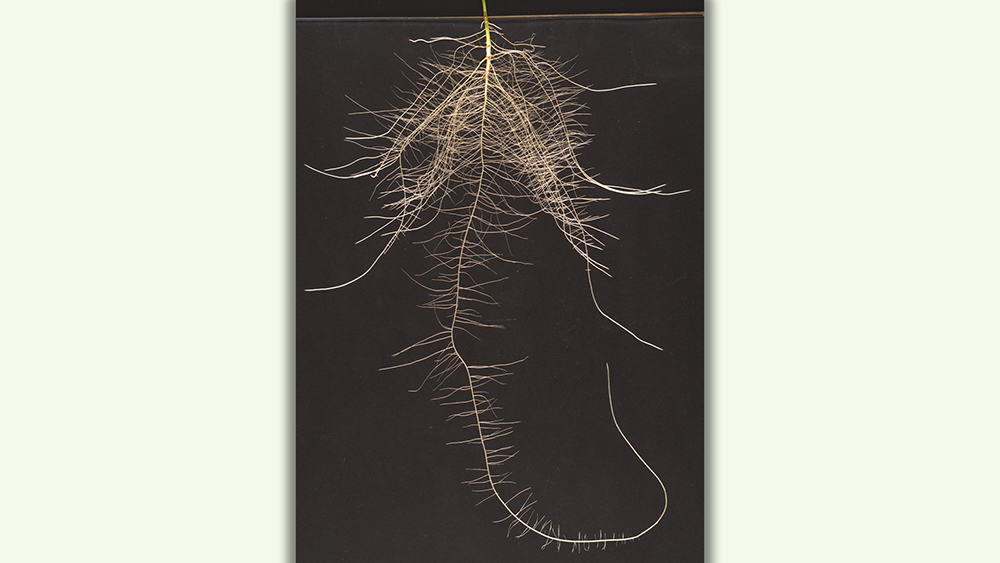
A better understanding of plant root structure could lead to more efficient nutrient use in crops, say researchers at the Global Institute for Food Security (GIFS).
In a recent academic review, “Getting to the roots of N, P, and K uptake,” published in the Oxford Academic’s Journal of Experimental Botany, lead author Dr. Wendy Lyzenga and co-authors make the case for a renewed look at root structure in understanding the genetic influence in overall plant growth and nutrient uptake. Lyzenga suggests that doing so could impact how researchers do crop breeding and perhaps lead to even more effective fertilizer applications, improving yields while reducing input costs and environmental impact.

Dr. Wendy Lyzenga
“While fertilizer is a critical tool for crop productivity, only a fraction of mineral nutrients are taken up by the roots,” said Lyzenga. “Part of what we’re trying to highlight by writing this review is that if we improve the properties of roots, the nutrient uptake capacity of roots, and we can pull more of those nutrients out of the soil so that we get better uptake by our crops, there is better economic, environmental and social value for the producer and other stakeholders.”
Healthy soil is a complex environment teeming with microbes, fungi and various chemical elements that all interact in intricate ways. But this environment is not uniform. Nutrients, moisture and microbes essential to plant growth are unevenly distributed.
Microbial communities are vital for nutrient uptake in crop plants, so you want to encourage these beneficial relationships, says Lyzenga. As an example, she points to mycorrhizal fungi, a ubiquitous fungus that has a symbiotic relationship with the roots of many crop plants, interacting with plant roots and facilitating phosphate uptake.

Plant roots are challenging to measure and study,
but they have a big impact on crop traits, including nutrient uptake. (Photos courtesy of Dr. Zhigang Liu)
Many photosynthetic products made by the plant, including carbon, are consumed by fungi in this relationship. In return, carbon is exchanged by the crop plant for equal amounts of phosphate and moisture from fungi. So, for producers, finding balance is important to crop productivity and long-term soil health.
Besides microbes, healthy soil also needs a delicate balance of carbon and nitrates for plant growth to take place. Plants take carbon from the air and fix it to a sugar molecule, and then combine this with nitrogen to create proteins, the building blocks of life you learned about in grade school.
You need to have a carbon-nitrate balance, says Lyzenga. And plants do some “really fascinating communication between leaves and roots” that indicates how much carbon and sunlight a plant is getting. The more sunlight the plant receives, the more the plant signals to the root system to take up phosphate, nitrogen or potassium.
Dr. Zhigang Liu, postdoctoral fellow in root-soil-interactions at GIFS and a co-author of the review, says crop breeders often focus on what’s happening above ground in determining desirable traits in a plant. But he suggests this may be leaving valuable opportunities in the ground.
“In the review, we tried to highlight the relationship between nutrient uptake and root physiology with this noble goal of encouraging people to look more at roots and to incorporate root phenotyping into their experimental analysis,” said Liu.
Part of the research that’s going on at GIFS is to identify genes that impact overall root growth, he says. A larger root system means more surface area with the soil and greater capacity to take up nutrients, reducing input costs while improving plant growth.
“If you know what gene is responsible for nitrate uptake, and you know about some different versions of that gene and which one is more important, or which one is better at it [and] if you can find one of those variants, then you can incorporate that variant into your breeding program,” said Lyzenga.
She suggests finding solutions is complicated, because phenotyping roots is challenging, and most has been done in the idealized state of a lab. But breeding for improved roots, she says, is an unrealized opportunity for advancing nutrient uptake in crop plants and improving plant health both above and below ground.
